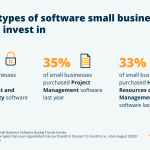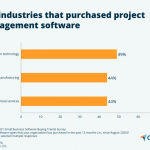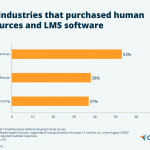Small Businesses Reveal The Types of Software That Helped Them Survive 2021
Cybersecurity, project management, and human resources software made a huge impact on the survival of small businesses in 2021.
Every year, Capterra runs a global small business survey that digs into software and tech trends to surface insights that matter to you and your peers.
Businesses can’t survive without technology, so the stakes for software purchases are high. The overwhelming number of different technologies, vendors, and available options means that business leaders run the risk of making the wrong decision without the right information.
Our survey gives business decision-makers a look behind the curtain at what kinds of software their peers and competitors are investing in today—insights that can be critical in guiding your next software purchase.
We polled 500 small and midsize businesses (SMBs) that have been in operation for at least 12 months and have no more than 500 full-time employees currently on staff to ask about the software they purchased in 2021. We also asked about the kinds of challenges they were trying to solve, and what their experiences with researching and purchasing software involved. Based on our survey results, we identified three types of software that all businesses should have in their toolkit:

In this report, we’ll explore each of these types of software, their top industry adopters, and the challenges they can help you solve.
IT management and cybersecurity
In our survey, we asked businesses what types of software they purchased in 2021, and IT management and cybersecurity was the top choice with 46% of businesses saying they invested in this tech last year.
Data breaches and cyberattacks are increasing year over year, and the cost of such data vulnerabilities is growing right along with them.
Gartner predicts that cyber-physical system (CPS) attacks (including things such as insurance and litigation fees, compensation, fines, and loss of business) could cost businesses worldwide as much as $50 billion by 2023. What’s more, Gartner believes that 75% of CEOs will be held personally liable for CPS incidents by 2024.
According to our survey, the average cost of IT management and cybersecurity software varied in 2021. Of businesses that purchased these tools, almost half (48%) spent at least $10,000 or as much as $75,000.

Top IT management and cybersecurity software adopters by industry
Our survey found three industries that adopted IT management and cybersecurity software more than any others: Information technology, healthcare, and financial services.

Information technology
The IT industry makes sense as the top adopter of IT management and cybersecurity software. Businesses that identified themselves as part of this industry in our Small Business Software Buying Trends Survey* included software vendors and service providers (e.g., data processing, consulting, and system integration).
With the sheer amount of data these businesses handle—and the fact that service providers are handling that data on behalf of other businesses—protecting themselves from any type of data loss is critical.
Healthcare
The healthcare industry is also facing an increased threat to their data these days, which is especially dangerous as such businesses hold protected health information and could face additional fines due to HIPAA laws in the event of a breach.
Add to this the fact that remote patient monitoring tools are gaining popularity, and you have a perfect storm of data vulnerabilities that healthcare organizations are right to want to protect themselves from.
Financial services
Financial service providers such as retail and commercial banks, investment or brokerage firms, and wealth management firms all have a keen interest in protecting their data.
Many small businesses handle their own finances via accounting software or even Excel spreadsheets, which leaves them open to human error or software vulnerabilities. When it comes to financial institutions dealing with other people’s money, there’s really no room for error.
Project management
The value of finding tools to help with time and task management has increased dramatically since the onset of the pandemic and the subsequent increase of remote work, which explains why so many of our survey respondents purchased new project management software in the past year.
According to a Capterra survey from July 2020, 84% of employees are moderately or completely satisfied with remote work, but that statistic has to come hand-in-hand with the recognition that a heavier workload doesn’t equal a more productive employee. You can’t fill more work into the free time that remote employees gain by not having a commute to the office and still expect the best results. Gartner reports that employees function best when their workloads are between 70% and 80% of their total bandwidth.
This is why knowing the true availability of employees and assigning the right workload to optimize effectiveness and productivity isn’t easy to do. Enter project management software.
Top project management software adopters by industry

Information technology
Once again, the IT industry is the leading adopter for one of businesses’ must-have software systems in the past year. With the number of tasks and deadlines IT teams face on any given project, it’s no wonder so many are looking for solutions to help them manage their time and to-do lists.
Collaboration is also a huge element in any software developer or IT management organization, which makes certain project management tools that have collaboration or communication features ideal.
Manufacturing
With the current global supply chain issues we’re facing, manufacturing organizations cannot risk delays caused by miscommunication or error. That’s one big reason so many turned to project management software in 2021.
Project management software tends to fall into one of three categories:
- Collaborative: Allowing multiple people to work on one project together
- Top-down: Allowing one person to work on a project at a time
- Integrated: Allowing multiple departments within an organization to work on the same project
Because of these options, different manufacturers may need different project management solutions to gain full control over their workflow.
Financial services
As we brace for the prospect of another recession, financial institutions will face increased scrutiny when it comes to managing their businesses. This makes completing projects on time and successfully a huge priority for all types of financial service providers.
To prepare for that (and to better manage tasks in the meantime), many such institutions have adopted PM software in the past 12 months.
Human resource or learning management systems
Finally, our survey found that a third of small businesses across the world purchased human resource (HR) software or a learning management system (LMS) in 2021. In the midst of “The Great Resignation,” that’s to be expected.
Employees hold a lot of power in today’s climate (and are gaining even more), and that makes finding and retaining qualified workers a massive challenge for businesses. One way to combat the massive turnover companies are now dealing with is by addressing toxic workplace culture, which is a leading cause of “The Great Resignation.”
According to a recent Capterra survey, transitioning to a remote workplace can be just the thing to solve this. We found that 70% of HR leaders had fewer complaints about toxic workplace behavior after they transitioned to hybrid or remote work.
Top Human Resource and LMS software adopters by industry

Financial services
Banks are no exception to the rule that keeping employees happy is a top priority, and creating a hybrid workforce is one way this industry can do that. While making such a major change to the way employees work can be daunting, there are plenty of technologies and tools within the realm of HR software that make this simple.
Video conferencing software can easily facilitate client meetings, employee monitoring software can ensure teams are staying productive, and engagement tools can keep your team focused and invested in your goals.
Healthcare
The healthcare industry has been hit hardest by the pandemic and an unprecedented increase in employee burnout, which makes taking care of healthcare workers a moral imperative for their employers.
Considering the challenges employees are facing today, Capterra predicts that 30% of businesses will have a dedicated chief wellbeing officer to manage employee mental health by 2030. In the meantime, businesses can look into tools such as corporate wellness software and employee advocacy software to help their workforce overcome burnout.
Manufacturing
The current health crisis is not the only alarming issue we’re facing—global supply chain shortages are taking a huge toll on manufacturing employees as well. As this is one industry where remote or hybrid work isn’t an ideal or feasible option, providing the most-desired employee benefits is the best approach for manufacturers.
Keep learning to keep thriving
Knowledge is power, and arming yourself with as much as you can empowers you to make the best business decisions. And we’ve got more knowledge to offer.
Explore more research, how-to guides, and business trends on Capterra’s blogs, which are sorted by industry to help you find the most relevant information and stay up-to-date with your field.
Methodology
* Capterra’s 2021 Small Business Software Buying Trends study was conducted to identify the software buying behaviors of small and midsize business (SMB) owners in the past 12 months.
The research was conducted online from August through October 2021 among 500 respondents from the U.S., Canada, Spain, France, and Germany, and from SMBs with revenue of less than $250 million and with two to 499 employees. Respondents were screened for their involvement in software purchasing decisions. Those who were group leaders/members or had significant influence qualified for the study.
The post Small Businesses Reveal The Types of Software That Helped Them Survive 2021 appeared first on Capterra.
Read More
Author: Lisa Hedges




